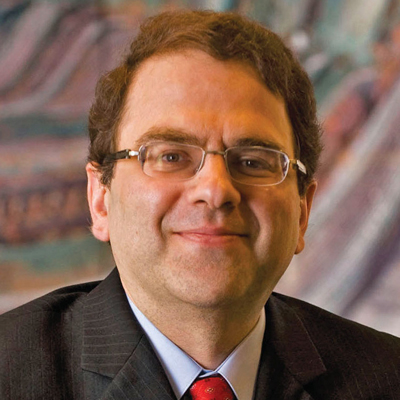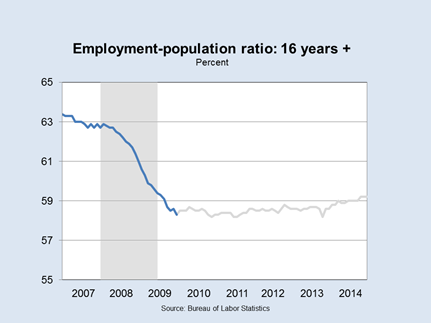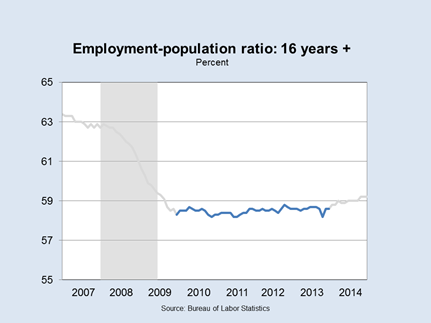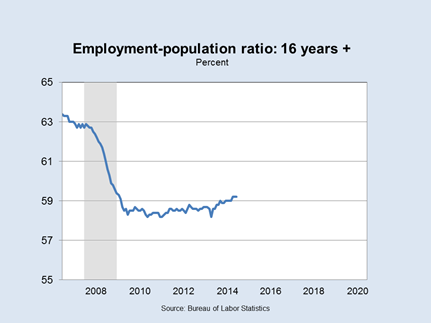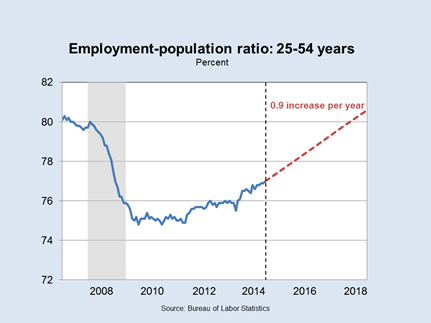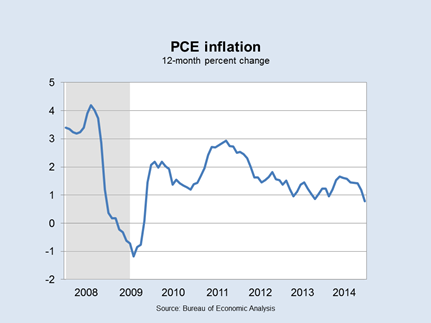Note1
Thank you for that generous introduction, and thank you for the opportunity to speak to you today.
The title of this speech is “We Can Do Better.” At the end of 2013, many observers were concerned that the Great Recession of 2007-09 had created a new downgraded baseline for U.S. labor markets. But, as I will show you, the United States experienced rapid improvement in labor market performance in 2014. There is no longer evidence that the American labor market is trapped in some kind of dismal “new normal” in the wake of the Great Recession.
In the absence of such evidence, I believe that policymakers should strive to facilitate ongoing improvement in labor market outcomes until they more closely resemble those that prevailed before the Great Recession. I use a series of charts to show that the process of improvement is likely to take some time. By some key metrics, the labor market improved more in 2014 than it had in almost 20 years. Yet, by these same metrics, we would need to see at least three more years like 2014 for labor market conditions to return to their 2006 levels. It follows that monetary policymakers should be extraordinarily patient about reducing the level of monetary accommodation.
This recommendation contrasts with the suggestion heard from others that the Federal Open Market Committee should begin to raise the target range for the fed funds rate (for short-term interbank loans) relatively soon. In the latter portion of my talk, I will discuss what I perceive to be the two main arguments supporting this alternative recommendation and why I do not find these arguments compelling. A key bottom line of this discussion is that I expect that it will take several years for the FOMC to achieve both its price and its employment objectives. In this sense, I do not perceive any tension between the two macroeconomic goals of the Committee.
I look forward to taking your questions at the end of my prepared remarks. For me, those questions are a highlight of these speaking engagements. As I will discuss, two-way communication between policymakers and citizens is a core function of the Federal Reserve System. Your questions are a key part of that two-way communication.
The views that I express today are my own and are not necessarily those of others in the Federal Reserve System.
Federal Reserve System basics
Let me begin with some basics about the Federal Reserve System. I like to tell people that the Fed is a uniquely American institution. What do I mean by that? Well, relative to its counterparts around the world, the U.S. central bank is highly decentralized. The Federal Reserve Bank of Minneapolis is one of 12 regional Reserve Banks that, along with the Board of Governors in Washington, D.C., make up the Federal Reserve System. Our bank serves as the headquarters for Federal Reserve operations in the ninth of the 12 Federal Reserve districts, which includes Montana, the Dakotas, Minnesota, northwestern Wisconsin and the Upper Peninsula of Michigan.
Eight times per year, the Federal Open Market Committee—the FOMC—meets to set the path of monetary stimulus over the next six to seven weeks. All 12 presidents of the various regional Federal Reserve banks—including me—and the governors of the Federal Reserve Board contribute to these deliberations. However, the voting members of the Committee itself consist only of the governors, the president of the Federal Reserve Bank of New York and a rotating group of four other presidents. In this way, the structure of the FOMC mirrors the structure of our government, because representatives from different regions of the country—the various presidents—have input into FOMC deliberations.
This decentralized system has many desirable attributes. I believe that one of the most important is that it facilitates two-way communication between the nation’s central bank and the nation’s citizens. We’re engaging in one direction of this communication right now, as I tell you about key considerations regarding monetary policy. In the other direction, the Federal Reserve Bank of Minneapolis gathers valuable economic information from local contacts in a variety of ways. Indeed, earlier this week, I met with the Federal Reserve Bank of Minneapolis’ Great Plains Advisory Council—which includes business and community leaders from North and South Dakota—to gather exactly this kind of information. The public service of these people, and their many contacts, help ensure that we have a deeper understanding of what is happening in the local economy.
But let me turn back to the FOMC and the making of monetary policy. I mentioned that the FOMC meets eight times per year. At those meetings, we decide on an appropriate stance of monetary policy for the economy. What is the FOMC seeking to achieve by varying monetary policy? Congress has charged the FOMC with making monetary policy to promote maximum employment and to promote price stability. The FOMC has interpreted the second goal, price stability, to mean keeping inflation close to 2 percent.
Employment over the past eight years
I now turn to the FOMC’s performance with respect to its employment mandate over the past eight years—from December 2006 through December 2014. Many metrics are used to measure labor market performance. I will concentrate on what I see as the most basic of these metrics: the fraction of people who have a job.
I begin with the three-year period from December 2006 through December 2009. This was a period of relatively rapid deterioration in labor market performance. The fraction of the population over the age of 16 who had a job fell from over 63 percent to just over 58 percent. These people did not suddenly become disabled. Nor did they suddenly decide that they could have more fun playing video games than working. Rather, there was a large group of people with talents and skills who would have been employed in 2006, but were not being utilized by the U.S. economy three years later. In this sense, the 5-percentage-point decline in the employment-to-population ratio represents a dramatic and disturbing waste of America’s valuable human resources.
I next show you the four-year period from the end of 2009 through December 2013. At the beginning of this period, 58.3 percent of the population over the age of 16 had a job. At the end of this four-year period, 58.6 percent of the population over the age of 16 had a job. The employment-population ratio remained essentially unchanged for four years.
There is a reason to be cautious about viewing this constancy as a sign of stagnation. More and more of the baby boom birth cohort—born between 1946 and 1964—are reaching an age at which we would generally expect them to retire from working. Many think that it would be natural for this demographic force to exert downward pressure on the FOMC’s maximum employment goal.
One way to strip out this demographic effect is to look at the behavior of the fraction of those aged 25 to 54 who have a job. Here, we’ve plotted that statistic from December 2006 to December 2013. Its behavior is qualitatively similar to what we see for those aged 16 and over. The fraction of those aged 25 to 54 who had a job fell rapidly from the end of 2006 to the end of 2009. This fraction did grow slightly from 2009 to 2013—but the pace of recovery was sluggish at best.
These kinds of data on employment led more than a few observers to be concerned at the end of 2013 that the U.S. labor market was stuck in some kind of adverse “new normal.” Fortunately, we see in the next chart that 2014 showed that this kind of pessimism was unwarranted. In 2014, the fraction of people over the age of 16 who have a job grew by 0.6 percentage points. Although this increase looks modest in the chart, it is equivalent to about 1.4 million jobs (beyond what is required to match population growth) and is tied for the largest December-to-December increase in 17 years.
In a similar vein, the fraction of people between the ages of 25 and 54 who had a job rose by 0.9 percentage points—the largest December-to-December increase in over a quarter century.
To summarize: We saw tremendous improvement in labor market outcomes in 2014. In the wake of this improvement, there is no reason to think of the Great Recession as leading to some kind of “new normal” with weak labor market outcomes.
Promoting maximum employment and extraordinary patience
As I mentioned earlier, the FOMC has been charged by Congress with making monetary policy so as to promote maximum employment. In my view, the performance of the labor market in 2014 has large consequences for how the FOMC should interpret this congressional mandate.
At the end of 2013, the fraction of the population over the age of 16 with a job had remained essentially unchanged for four years. It was plausible—although depressing—to think that labor market performance had been permanently degraded by the Great Recession of 2007-09. Under this pessimistic “new normal” perspective, the FOMC could have been seen as being close to fulfilling its maximum employment mandate.
But 2014 blew up that possibility. As I noted earlier, last year featured the largest improvement in labor market performance in many years. This dramatic change is not consistent with an economy stuck in a post-recession new normal. The pessimists were wrong—and so the FOMC should be aiming to facilitate a continuation of the 2014 improvement in the labor market.
How close then is the FOMC to its maximum employment goal? At any point in time, there are large uncertainties about the long-run level of employment in the economy. But the remarkable improvement that we saw in 2014 is strong evidence against the hypothesis that the Great Recession or slow recovery has permanently damaged the U.S. labor force. Without clear signs of such damage, I believe that it is natural for the FOMC to treat the pre-recession year of 2006 as a key guidepost in formulating its employment objectives.2
This raises a natural question: If we think of 2006 as representing maximum employment, how long will it take for the U.S. economy to get back to maximum employment? I now want to show you, via some simple calculations, that we will need at least three more years as good as 2014.
Here’s what I mean. This is a graph of the employment-population ratio from December 2006 through December 2014. We can see that the fraction of people over the age of 16 who have a job in December 2014 remains well below what it was eight years earlier.
Now, we extend the graph by assuming that the next six years were as good as 2014. The employment-population ratio in December 2020 would still be below that in December 2006.
As I noted earlier, we should be cautious about using this measure of labor market health in light of the aging of the baby boom birth cohort.3 In this next chart, I’ve done a similar extrapolation using the employment-to-population ratio for those aged 25 to 54.
Here, we assume that we had four more years in a row like 2014—that is, 2015, 2016, 2017 and 2018 were all as good as 2014. Then, the fraction of those aged 25 to 54 with a job will be slightly above its level in early 2007.
What do we conclude from these pictures? I’ve suggested that, given the absence of clear evidence of post-recession damage, the strong labor market conditions of 2006 are a natural benchmark characterization for the FOMC’s goal of maximum employment. Under this perspective, the Committee needs to make policy choices that will lead to more great years like 2014—not one more year like 2014, not two more years like 2014, but at least three more years like 2014. My own assessment is that the Committee will only be able to achieve this outcome by being extraordinarily patient about reducing the level of existing monetary accommodation. In particular, I don’t see raising the target range for the fed funds rate above its current low level in 2015 as being consistent with the pursuit of the kind of labor market outcomes that we are charged with delivering.
What’s the rush?
I’ve explained why I believe the FOMC needs to display extraordinary patience in any reduction of monetary accommodation in order to achieve its maximum employment objectives. Yet, more than a few observers have suggested that the FOMC should raise its target range for the fed funds rate soon—possibly as soon as June. I now want to turn to what I see as the two main arguments underlying this alternative perspective and explain why I don’t find them compelling.
Price stability
The FOMC is charged with promoting maximum employment. However, it is also charged with a second goal: promoting price stability. Accommodative monetary policy pushes upward on prices. In principle, keeping policy sufficiently accommodative to achieve maximum employment could lead inflation to be too high. Along those lines, some observers have suggested that it’s necessary to raise the target for the fed funds rate soon in order to keep inflation under control.
This suggestion is theoretically plausible, but it seems sharply at odds with the actual behavior of inflation data. The FOMC has translated price stability to mean a personal consumption expenditures (PCE) inflation rate of 2 percent. Here’s what inflation has looked like over the past seven years, through the end of 2014. It has averaged 1.4 percent. As of the end of 2014, it was 0.8 percent. It has been below 2 percent for nearly three years.
It is generally thought, though, that monetary policy affects prices and employment with a lag of about 18 to 24 months. Hence, monetary policymakers need to base their decisions on their forecast for inflation over that horizon. My own expectation is that the inflation rate will be below 2 percent until 2018. Inflation is a variable that typically evolves slowly. It has been below 2 percent for a long time, and it is unlikely to move back to 2 percent rapidly. To be clear, as we saw in 2011, changes in oil prices could lead inflation to blip above 2 percent for a few months. But I don’t see inflation returning to 2 percent in a sustained way for three years—possibly longer. And my perspective mirrors that of Federal Reserve Board staff. The minutes from the March FOMC meeting specifically state that the staff outlook is that inflation will remain below 2 percent through 2017.
Why do others see stronger inflationary pressures? I believe that they are, implicitly or explicitly, basing their assessments on an economic relationship called the Phillips curve. According to the Phillips curve, as the unemployment rate falls, the growing scarcity of workers should push up on wages and prices. The unemployment rate has fallen steadily over the past few years, and it is thought by some that this decline should generate 2 percent inflation in the next year or two.
There is sound economic theory underlying the Phillips curve, and I agree that these basic forces are at work in the labor market. The problem is that, for a number of reasons that we don’t fully understand, the Phillips curve moves around a lot over time. These movements make it hard for policymakers to make use of the Phillips curve in practice—for example, to know how to translate the current unemployment rate of 5.5 percent into a useful estimate of future inflation. Accordingly, a key lesson of the past 15 years of research on inflation dynamics is that, except possibly during the initial onset of recessions, forecasters should put relatively little weight on the Phillips curve in formulating their predictions about the future course of inflation.4 That lesson informs my own inflation predictions.
To sum up: The FOMC is charged with making monetary policy so as to promote maximum employment and price stability. There is no tension between these two objectives at the current time. I expect that it will take several years for employment to return to its maximal level. I expect that it will take several years for inflation to return to target. The FOMC can best facilitate its pursuit of both mandates by forgoing any near-term reduction in the level of monetary accommodation.5
Financial stability
I now turn to the second factor that leads observers to favor raising interest rates soon: financial stability.
There are two distinct concerns about financial stability. The first is that excessive risk-taking in the financial sector could make the macroeconomy more vulnerable to adverse shocks. It is thought by some that raising interest rates could modulate this kind of behavior and these kinds of vulnerabilities. The good news is that Federal Reserve staff carefully monitors the financial system for exactly these kinds of vulnerabilities. I see little evidence in their analysis to suggest that a monetary policymaker should see financial stability risks as being in any way material. Capital and liquidity are high in the banking sector. Maturity transformation remains modest. The level of borrowing among households and nonfinancial firms remains low.
The second concern is that the financial system may be vulnerable to an unduly rapid increase in interest rates. To forestall this risk, some observers recommend that the FOMC begin to raise interest rates soon, so that the path of interest rate increases could be more gradual. My own perspective is that, in light of the outlook for unduly low employment and unduly low inflation, the FOMC can be both late and slow in reducing the level of monetary accommodation.
To be more specific, based on my current assessment of the future evolution of the economy, I anticipate that it would be appropriate for the FOMC to defer the initial interest rate increase until the second half of 2016. It would then be appropriate under my outlook for the FOMC to raise the target range for the fed funds rate thereafter to about 2 percentage points by the end of 2017. This would be slower than the last tightening of monetary policy in 2004 to 2006.
Conclusions
Let me conclude.
I am an economist, and economics is often, with good reason, called the “dismal” science. But my message to you today is one of hope and optimism.
From 2006 to 2009, we saw a marked deterioration in labor market performance. As recently as a year ago, it seemed like this loss of human resources might prove to be permanent. But the rapid growth in employment that we saw in 2014 shattered this hypothesis. The lesson of 2014 is clear: We can do better. The FOMC is charged with promoting maximum employment. In the wake of 2014, I see no reason why the Committee should not aim to facilitate continued improvement in labor market conditions. Indeed, I see no reason why we should not aim for the kind of strong labor market conditions that prevailed at the end of 2006.
But we will only get there if we make the right choices. The FOMC can only achieve its congressionally mandated price and employment goals by being extraordinarily patient in reducing the level of monetary accommodation. Under my current outlook, I continue to believe that it would be a mistake to raise the target range for the fed funds rate in 2015.
Thank you for listening. I look forward to taking your questions.
Endnotes
1 Thanks to Cristina Arellano, David Fettig, Terry Fitzgerald, Rob Grunewald, Jenni Schoppers and Sam Schulhofer-Wohl for their assistance with these remarks.
2 The fraction of those aged 25 to 54 with a job declined slightly from 1999 to 2006. Some have argued that this seven-year statistical pattern is evidence of an ongoing long-term trend decline in employment that monetary stimulus cannot offset without generating undue inflation. However, I am unaware of any economic research that explains the sources of this decline in the 2000s and then documents that these underlying factors have continued to evolve in the same way since 2006. See also footnote 3.
3 Of course, the demographic trends associated with the baby boom birth cohort have been well-understood for years. In November 2007, the Bureau of Labor Statistics released its forecast for the evolution of employment from 2006 to 2016. (See Franklin 2007.) This outlook took full and careful account of a wide variety of demographic trends. It projected that, by 2016, 62.2 percent of those aged 16 and over would have a job. The employment-to-population ratio at the end of 2014 was still about 3 percentage points short of this forecast for 2016.
4 See, among others, Fuhrer and Olivei (2010), Stock and Watson (2010) and Dotsey, Fujita and Stark (2015).
5 In their recent thoughtful analysis of U.S. labor market conditions, Blanchflower and Levin (2015, page 12) reach a similar conclusion that “initiating monetary policy tightening would be premature at this stage.”
References
Blanchflower, David G., and Andrew T. Levin. 2015. “Labor Market Slack and Monetary Policy.” Manuscript, Dartmouth College.
Dotsey, Michael, Shigeru Fujita and Tom Stark. 2015. “Do Phillips Curves Conditionally Help to Forecast Inflation?” Working Paper 15-16. Federal Reserve Bank of Philadelphia.
Franklin, James C. 2007. “An Overview of BLS Projections to 2016.” Monthly Labor Review. Bureau of Labor Statistics.
Fuhrer, Jeffrey C., and Giovanni P. Olivei. 2010. “The Role of Expectations and Output in the Inflation Process: An Empirical Assessment.” Public Policy Brief 10-2. Federal Reserve Bank of Boston.
Stock, James H., and Mark W. Watson. 2010. “Modeling Inflation after the Crisis.” Proceedings—Economic Policy Symposium—Jackson Hole. Federal Reserve Bank of Kansas City, pages 173-220.

